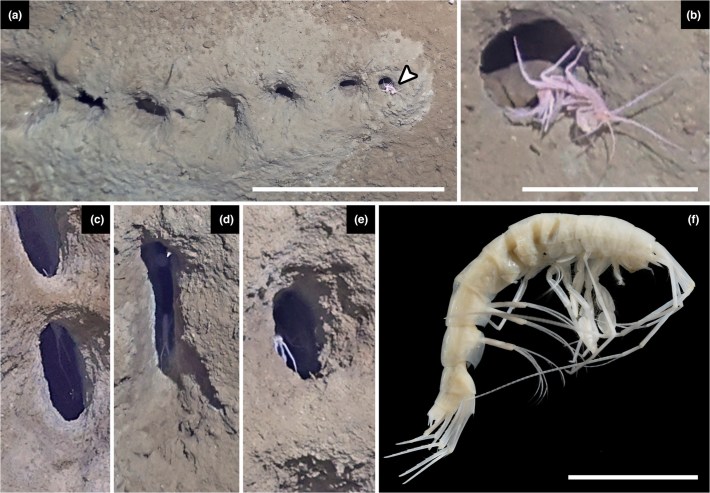One week in July, scientists aboard a research cruise north of the Azores stumbled upon a series of rectangular holes in the seafloor. They were mystified. What thing had made these tracks, so eerily perfect, so deeply unsettling? The scientists suspected the tracks represented a burrow created by some bottom-dwelling creature, and posted the holes on the internet to see if anyone recognized them. But no one did.
That same week, scientists aboard a totally different research cruise across the world in the Bering Sea also discovered a strangely similar series of seafloor holes. They, too, were mystified. They had lowered a camera off the ship, where it dangled more than 11,000 feet underwater in order to film abyssal plains—vast expanses of seafloor without much going on. "It's a lot of mud," said Julia Sigwart, a biologist at the Senckenberg Research Institute and Natural History Museum in Frankfurt. But creatures lurk, drift, and burrow in this sludge, including swimming sea cucumbers that resemble inflated cow udders, and single-celled xenophyophores that resemble ruffled cabbages.
The scientists aboard the cruise often gathered for watch parties to record anything that appeared in the footage while also snacking and hanging out. The holes appeared on the very first camera deployment. "We're like, what is that? That's a weird thing!" Sigwart said. The holes all occurred within larger mounds, suggesting they were burrows, with sediment being pushed up from underneath and spilling around the holes. And they kept appearing, so frequently that the scientists gave them a nickname—favorite burrow—that the watch parties shouted out whenever the holes appeared on screen. "Favorite burrow!" Sigwart shouted, as an example, on our call.

The Bering Sea expedition was primarily a biology cruise, with experts in many different animal groups aboard. After they'd seen hundreds of the holes, they held a meeting—flicking through photos of creatures spotted near the holes to suss out the most likely hole-maker. "Everybody sort of had their own speculation, and their own reason why their organisms couldn't possibly have made it," Sigwart said. "So we were able to eliminate lots of possibilities." Some fish make complicated, geometric nests, but rarely in lines. The grenadier fish often seen loitering above the burrows were too big too fit inside the holes. Annelid worms are known to burrow, but their squiggly bodies didn't seem capable of crafting such openings.
When a photo of a shrimp-like crustacean called an amphipod appeared on screen, someone stood up and screamed, "That's it!" and ran out of the room, Sigwart said. The screamer was Angelika Brandt, the head of marine zoology at Senckenberg. Brandt returned about 10 minutes later carrying an external hard drive with video footage from the 1980s of an amphipod from Antarctica. Filmed by zoologist Charles Oliver Coleman, the video showed the amphipod burrowing in the exact same posture as the one filmed by the Bering Sea holes.

The most obvious benefit to a burrow is protection from predators. "Most big structures that are made by organisms, including us, have more than one purpose," Sigwart said. The researchers hypothesize the amphipod may be "eat-digging" its way through a nutritious sediment layer below ground. And the burrow could even be used for parental care, as the burrowing amphipod from Antarctica cares for its young and co-habitates across generations.

Despite roving the remote Bering Sea, the ship had a good internet connection. After reading about the other sets of mysterious seafloor holes near the Azores, Sigwart emailed Mike Vecchione, a zoologist at the Smithsonian National Museum of Natural History and an author of a paper published earlier that year about the mystery of the Azores holes. Could the resolution of one deep-sea hole mystery have inadvertently solved another?
Unfortunately, it would not. After comparing photos, Sigwart and Vecchione were "completely convinced" that the two types of holes were made by different organisms, Sigwart said. The Bering Sea Holes were all clearly interconnected by a single underground shaft, surrounded by a small mound formed by kicked-out sediment. But the holes by the Azores continued in straight lines for long distances, and it was not clear if any of the holes were connected. When I asked Sigwart if this at least meant scientists could rule out amphipods as the makers of the Azores holes, she laughed, adding that she expects those holes were created by something different but she also could not rule out the crustaceans. "I really don't know. I don't know," she said.
What have we learned from the saga of these two deep-sea hole mysteries, one solved and one still stubbornly mysterious? I, too, really don't know. Sometimes going into a hole leads you to curiosity and to wonder. Sometimes going into a hole leads you to a shrimp thing.






